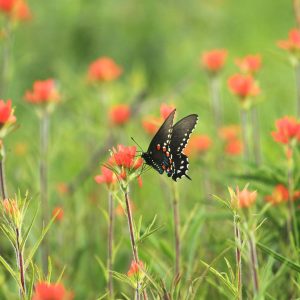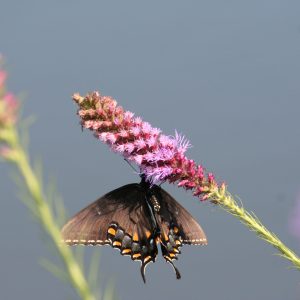Sawtooth Sunflower
Helianthus grosseserratus
Pollen & nectar are a favorite of pollinators, birds eat the seeds, and foliage is palatable to herbivores
$3.00 – $289.00
For quantity discount pricing, request a quote.
Description
Helianthus grosseserratus, commonly called Sawtooth Sunflower, is a native perennial forb (wildflower) that can grow anywhere from 3 to 12 feet tall depending on the growing conditions.
Wildlife notes
The most common visitors to the flowers are bees, especially long-tongued species. Among these are honeybees, bumblebees, and Cuckoo bees. Other insect visitors include Syrphid flies, bee flies, butterflies, moths, and beetles.
The seeds of sunflowers are a favorite food of such upland gamebirds and songbirds as the Bobwhite Quail, Hungarian Partridge, Mourning Dove, Redwing Blackbird, American Goldfinch, Lark Sparrow, and Savannah Sparrow. Such rodents as the Franklin Ground Squirrel, Thirteen-lined Ground Squirrel, Plains Pocket Gopher, Prairie Vole, and Meadow Vole eat the seeds and/or other parts of sunflowers. These animals probably help to spread the seeds into new areas.
When the Sawtooth Sunflower and other sunflowers are located near bodies of water, beavers and muskrats sometimes use their stems to construct dams or lodges. Deer and other hoofed mammalian herbivores occasionally browse on the foliage of larger sunflower plants, while groundhogs and rabbits are more likely to attack smaller plants.
Forage notes
This plant is palatable to livestock.
Landscaping notes
This species prefers full sun, moist soil, and fertile loamy soil with high organic content. However, this robust plant will tolerate other kinds of soil. Powdery mildew may affect the leaves, but this typically occurs during the fall after the blooming period. Strong wind can cause this plant to blow over in exposed situations. It also requires lots of room because of its large (sometimes huge) size and aggressive tendencies.
Restoration notes
Habitats include moist to mesic black soil prairies, thickets, moist meadows near rivers or lakes, Bur Oak savannas, bases of bluffs, fence rows, and areas along ditches, railroads, and roadsides. Sawtooth Sunflower thrives in both disturbed and high-quality sites, sometimes forming large colonies that exclude other plants. In Missouri, it is absent from most of the southeastern quarter of the state; scattered elsewhere; a wide variety of habitats.
This plant is commonly used in the following mixes: Wildlife Chuckwagon Mix
Watch a video about the Wildlife Chuckwagon Mix here.
Additional information
| Weight | N/A |
|---|---|
| Unit | Packet, Ounce, Pound |
| Light | Full Sun |
| Seeding Rate | 4 bulk lbs/acre |
| Soils | Average, Moist |
| Height | 40"-140" |
| Bloom Month | Aug, Sep, Oct |
| Color | Yellow |
| Specialty Uses | Wildlife |
| Cattle Palatability | Good |
| # seeds/pkt | 200 |
| Packet coverage area | 5 sq. ft |


